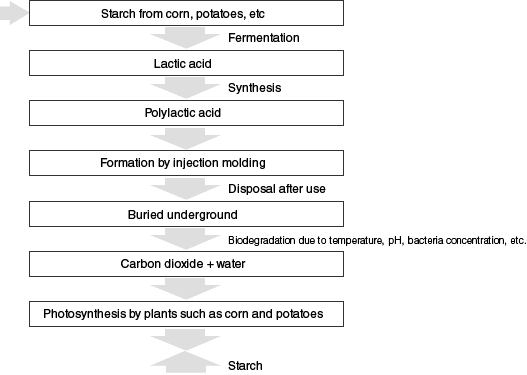#095 Injection Molding of Heat Resistant Polylactic Acid Resins
One of the typical biodegradable plastics is polylactic acid (PLA). Polylactic acid is a plant-derived biodegradable plastic resin. It is chemically synthesized using the following synthesizing process, and is recycled using the biodegradation effect.

Polylactic acid is relatively hard and has about the same mechanical strength as polystyrene. Although it is being used in industrial applications for about ten years, since the strength and heat resistance are insufficient, it has not been used much in industrial products of high added value.
However, recently, polylactic acids having good heat resistance have been developed by the application of nano composites technology. Since such materials can withstand deflection temperatures under load of up to 120°C, it has become possible to clean them in hot water, or to use them continuously in an environment of steam.
Therefore, its application has been opened up to one-way food containers (disposable food containers), returnable food containers (food containers used repeatedly such as in school lunches, etc.), personal computer enclosures, office automation equipment enclosures, bottle containers, packaging containers, etc.
In order to obtain the heat resistance property of polylactic acid, it is necessary to maintain the mold cavity surface temperature at about 110 to 120°C. Therefore, a cartridge heating apparatus or an oil temperature control mechanism is mandatory in molds.
Further, heat resistant polylactic acid has a large shrinkage ratio (about 12 to 20/1000), and has the property of strongly clinging to the core. Mold design and machining, and surface treatment that make the mold releasing resistance small become necessary. Therefore, it is very much necessary to consider the ejection structure.
In particular, ejection is extremely difficult in the case of deep molded product such as cases, containers, etc. Various types of technologies are being developed regarding the mold structure and injection molding methods that make it possible to realize smooth ejection of molded items as well as their heat resistance.



